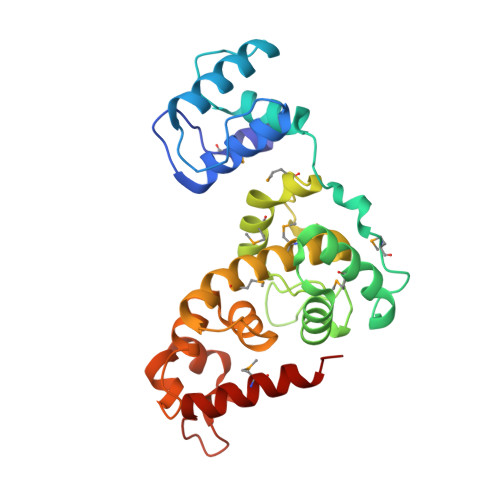Structure of the bacteriophage phi KZ lytic transglycosylase gp144.
Fokine, A., Miroshnikov, K.A., Shneider, M.M., Mesyanzhinov, V.V., Rossmann, M.G.(2008) J Biological Chem 283: 7242-7250
- PubMed: 18160394
- DOI: https://doi.org/10.1074/jbc.M709398200
- Primary Citation of Related Structures:
3BKH, 3BKV - PubMed Abstract:
Lytic transglycosylases are enzymes that act on the peptidoglycan of bacterial cell walls. They cleave the glycosidic linkage between N-acetylmuramoyl and N-acetylglucosaminyl residues with the concomitant formation of a 1,6-anhydromuramoyl product. The x-ray structure of the lytic transglycosylase gp144 from the Pseudomonas bacteriophage phi KZ has been determined to 2.5-A resolution. This protein is probably employed by the bacteriophage in the late stage of the virus reproduction cycle to destroy the bacterial cell wall to release the phage progeny. phi KZ gp144 is a 260-residue alpha-helical protein composed of a 70-residue N-terminal cell wall-binding domain and a C-terminal catalytic domain. The fold of the N-terminal domain is similar to the peptidoglycan-binding domain from Streptomyces albus G D-Ala-D-Ala carboxypeptidase and to the N-terminal prodomain of human metalloproteinases that act on extracellular matrices. The C-terminal catalytic domain of gp144 has a structural similarity to the catalytic domain of the transglycosylase Slt70 from Escherichia coli and to lysozymes. The gp144 catalytic domain has an elongated groove that can bind at least five sugar residues at sites A-E. As in other lysozymes, the peptidoglycan cleavage (catalyzed by Glu 115 in gp144) occurs between sugar-binding subsites D and E. The x-ray structure of the phi KZ transglycosylase complexed with the chitotetraose (N-acetylglucosamine)(4) has been determined to 2.6-A resolution. The N-acetylglucosamine residues of the chitotetraose bind in sites A-D.
- Department of Biological Sciences, Purdue University, West Lafayette, Indiana 47907-2054, USA.
Organizational Affiliation:




















